Common menu bar links
Bison on the comeback trail
Archived Content
Information identified as archived is provided for reference, research or recordkeeping purposes. It is not subject to the Government of Canada Web Standards and has not been altered or updated since it was archived. Please "contact us" to request a format other than those available.
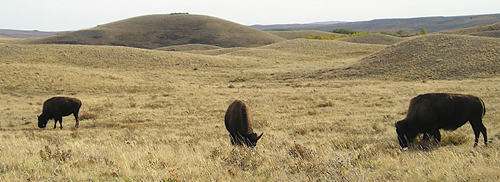
by Kelly Firmage-O'Brien, Statistics Canada
The once scarce bison population continues to grow on Canadian farms (Figures 1 and 2). According to the 2006 Census of Agriculture, the bison herd, at 195,728 head, has increased 34.9% since 2001.
Figure 1
Bison in Canada, census years 1991 to 2006
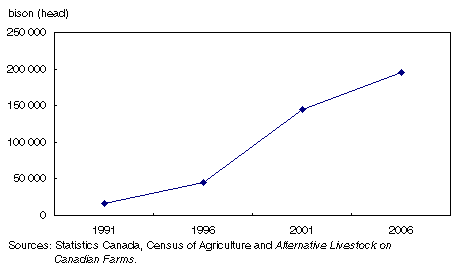
Canada's bison industry
Bison producers are concentrated in the Western provinces-British Columbia, Alberta, Saskatchewan and Manitoba-with less than 5% from Ontario and east. Alberta alone has 49.7% of the herd and 45.8% of the farms. Saskatchewan has the second largest bison herd (29.3%), followed by Manitoba (10.0%) and British Columbia (6.5%).
The Peace River region, in British Columbia and Alberta, is one of the country's key bison-producing regions, with 14.4% of the country's herd. The region, north of Grande Prairie in Alberta and encompassing Dawson Creek and Fort St. John in British Columbia, experienced a 59.9% increase in bison since the last Census of Agriculture, climbing from 17,661 in 2001 to 28,232 in 2006. Manitoba's largest bison population was in the South Interlake area located between the southern part of Lake Winnipeg and the southern part of Lake Manitoba, with over 5,000 head.
Figure 2
Number of farms reporting bison in Canada, census years 1991 to 2006
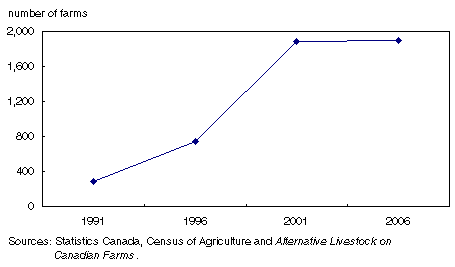
Giant of the prairie
Bison are large, hardy ruminants whose coat of long and coarse guard hairs and woolly undercoat gives them a two-toned appearance. Their long, shaggy, dark brown mane contrasts with an almost black beard and the hindquarters, with a short, straight, brown coat, also appear almost black. Bison have a keen sense of smell, excellent eyesight and a strong herding instinct. Although bison are commonly referred to as buffalo, the scientific name for the North American species is Bison bison.
North America has two types of bison, the wood bison (Bison bison athabascae) and the plains bison (Bison bison bison). The plains bison is the species primarily raised on agricultural operations while the wood bison, listed as threatened by the Committee on the Status of Endangered Wildlife in Canada, are bred as part of commercial herd development but in lesser numbers.

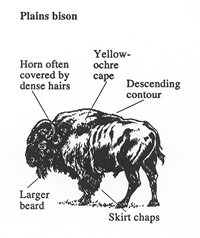
Historically the two types have had vastly different ranges: In Canada the plains bison was typically found in Alberta, Saskatchewan and Manitoba. The wood bison was found mainly in Northern Alberta, British Columbia and the territories.
The plains bison was dominant in the North American prairies up until the late 19th century. However, like many indigenous species at that time, bison were threatened with extinction as European settlers killed the animals for food and sport and converted millions of acres of their native grassland habitat into farmland.
Historical accounts estimate the North American bison population in the millions in the 1800s. William Temple Hornaday, in The Extermination of the American Bison, wrote that, "It would have been as easy to count or to estimate the number of leaves in a forest as to calculate the number of buffalos living at any given time during the history of the species previous to 1870." However, by the turn of the century this had all changed: Estimates suggest that by 1899 there were fewer than 1,000 bison left in North America.
The wild wood bison population is still struggling to increase in the face of disease and habitat loss from human development, agriculture, and natural resource development.
Natural grazers
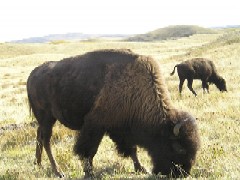
As native North American animals, bison are naturally adapted to the Canadian climate. Their biological makeup enables them to thrive despite winter storms and summer heat. Bison need only well-drained resting areas and natural or constructed shelters to protect them from extreme weather conditions. As indigenous animals, bison adapted over the centuries to drought and prairie fires that limited food availability by developing a slower digestive system than cattle, a characteristic that allows them to graze through most of what the Canadian climate can throw at them.
Bison can convert lower-protein forages into energy more efficiently than cattle and do very well in most types of pasture. However like cattle, the finishing diet of bison can be supplemented with grain to make them gain weight faster than a forage-only diet. Adding grain to the diet can also ensure a higher conception rate in bison cows, and will add fat making the meat more tender.
Not yet domesticated
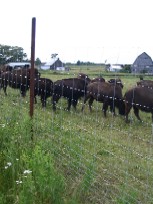
Despite their increasing popularity bison are still considered a wild species and haven't yet entirely adapted to life on a farm. Farm operators must understand their animals well in order to handle them safely.
When confined, a bison's first instinct is to flee-if they cannot, their tendency is to defend or attack. With a mature bison bull weighing up to 2,000 pounds and bison cows up to 1,100 pounds, handling these animals can be dangerous.
Since bison are such powerful animals the fencing is often stronger and higher than the fencing on a cattle operation. Penning and handling systems need to be designed to minimize stress on the animals and keep them from panicking. Like cattle, however, most of the time bison are content with an adequate supply of food and water. Bison operators report that with the proper equipment and experience, they can be as easy to handle as cattle.
Life cycle
Long-living animals, bison have an average life span of 20 to 25 years and do not fully mature until they are eight years old. A bison cow can be bred at age two, giving birth to her first calf when she is three years old.
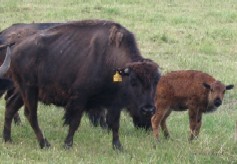
The bison breeding season-called the rut-normally stretches from late July to mid-September, with the majority of breeding taking place in August (see "Stuck in the same old rut?"). The gestation period for bison, at about nine months, is the same as for cattle and most calves are born in May or June.
At birth a bison calf usually weighs 50 to 75 pounds. Calves are weaned at seven to nine months of age when they weigh between 330 to 500 pounds. Most animals are ready for slaughter at between 20 and 30 months-about 950 to 1,050 pounds. Bulls finish sooner than heifers, but grass-fed animals take longer than 30 months to be finished. However, it is really the market that determines when the bison are finished-when demand for smaller carcasses is strong and they command higher prices, animals are sold earlier.
Bison also affected by the BSE crisis
Bison ranchers have faced challenges similar to the cattle industry in the last five years. In May 2003, when BSE (bovine spongiform encephalopathy) was found in a cow in Alberta, borders were closed to all live ruminant animals leaving Canada, including bison.
By August 2003 restrictions had been eased and the United States began accepting boneless meat from cattle and other ruminants less than 30 months old. By early 2005, the ban was lifted for all meat from animals younger than 30 months of age. However, live animals were not allowed into the United States until later in the year. The restriction on live animal exports highlighted a challenge to the bison industry that is familiar to many in the livestock business: the lack of domestic slaughter capacity. The number of bison slaughtered in federally and provincially inspected establishments went from 11,168 head in 2001 to 25,613 in 2006. Despite these challenges the market for Canadian bison meat has continued to grow, with 2006 exports of boneless bison meat more than double what they were in 2001 (Table 1). Live bison exports have also increased, spiking to 13,255 in 2006 after most countries had re-opened their borders to Canadian animals.
The number of bison continues to increase partly because health-conscious consumers perceive bison as being a more natural food product. Bison largely graze on pastures and tend to yield a meat that is low in fat and calories and high in iron. Table 2 compares the nutritional characteristics of bison meat to other meats.
Comeback trail for bison a long one
Bison, which used to number in the millions, played an integral role in the lives of the early inhabitants on the Canadian prairies. While the animal's future appeared threatened for a time, as more farmers raise bison and bison meat becomes increasingly available to consumers, Canadian agricultural operators are helping re-introduce this native species.
Stuck in the same old rut?
Wondering why you can breed cattle all year round, but bison only in certain seasons? It's called the estrous cycle.
Most female mammals will only become sexually receptive and mate when they are able to become pregnant-generally when they are ovulating. This period-known as estrus (also commonly known as "in heat")-is part of the estrous cycle, which determines how often an animal is fertile, and for how many days.
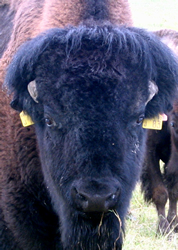
In the wild, it is often beneficial for animals to time their breeding with the seasons, giving birth in the spring when food is plentiful and their offspring have a better chance of survival. This cycle is triggered by changes in day length and the exposure to sunlight-this changes melatonin production, increasing hormone activities. The breeding season is also commonly known as "the rut."
This is why bison only generally breed between July and September, with most animals giving birth the following year between May and June. Other animals with seasonal breeding cycles include sheep, deer, and horses. Horses go through the estrous cycle and breed in the spring then give birth the following year, while sheep and goats come into heat from August to December and give birth five months later.
However farmers have developed some tricks to breed animals outside their normal reproductive seasons. Farmers keep lamps on in their barns for a specific number of hours per day, fooling animals into believing it is their breeding season and causing them to go into heat. Hormone treatments can also cause animals to go into heat outside their normal breeding season.
With domestication, some animals that used to have defined breeding seasons have become polyestrous, meaning that they will go through the estrous cycle continuously, ovulating and going into heat until they become pregnant. Historically, cattle had seasonal breeding patterns, but with generations of strategic breeding they became polyestrous. Although domestic pigs are descended from wild boars, which breed seasonally, they have largely overcome their seasonal reproductive patterns.

